![]()
SAO
![]()
• LITTLE VENICE •
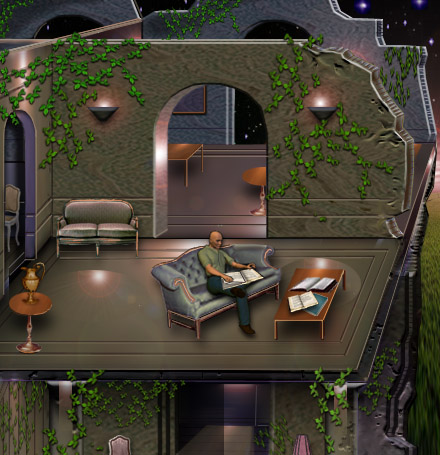
|
I was on the fifth floor of a towering house that had most of its ceiling and exterior walls missing, seated on a couch, my legs crossed and a book in my lap. I knew the house belonged to an older woman and I knew I had some communication with her previously, but could not recall her identity. I felt she was below, possibly sleeping, in another part of the house. Despite the ruined looking exterior, the house was elegantly furnished with beautiful antiques, 'homey' and brightly lit. Ivy laced many of the interior walls. I only sensed the broad vista of night which the house overlooked at this point, though it was wide open. |
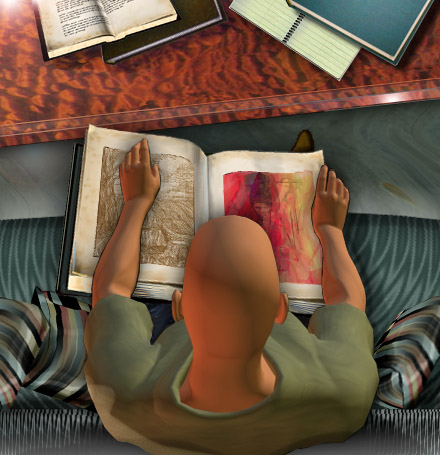
|
I became extremely lucid to the details of the richly embroidered couch and the silken pillows, the weight of the large book in my hands, the marble floor and the scintillating translucent golden burl of the 'tortoise shell' table top, strewn with books. It was cool and a little damp here. I noticed a broad, ancient water stain on the couch and the furnishings in the room gave off a rich, musty smell, as intense as a ripe peach. |

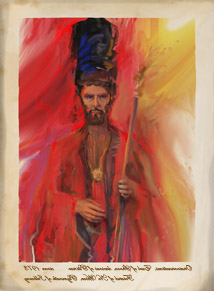
|
On the left page of the book was a scribbled drawing in gold ink of a woman toiling in a field of tall grass. On the right, a watercolor of a bearded man with a tall black turban and a scepter or golden staff. The images were very clear and beautiful, perfectly smooth, like prints. Artistically, and quite beyond my ability to reproduce faithfully, they were a striking mix of 'messiness' and great skill, the seemingly chaotic lines and strokes colliding with such mastery that I thought surely this was a classical art history book and that these were famous paintings, though it seemed strange that I knew I had not seen them before, as if, perhaps, they were 'lost works.' There was an elegant, flowery, back-handed script in dark gold beneath each which I spent a little time trying to decipher, but it appeared to be both an uncertain European language and backward. As soon as I had taken these images in, they began to display far more remarkable properties... |
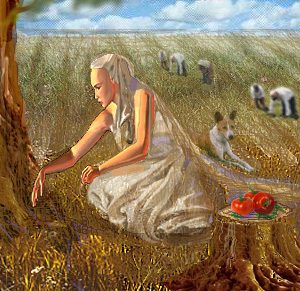
|
The drawing on the left began to pulse with bands of shadow and light that seemed to come from deep within the book, creating a spacious void beyond the ink. As I gazed at this, the effect became like waves of very fast, time lapse clouds passing over the scene, and I could feel the warm throb of light on my face as if near a pulsing lamp. The more I focused on this, the more 'real' aspects of the scene became, and the perspective began to shift and change wildly. What I was seeing was like a collage of time lapse films or a myriad of painted versions happening simultaneously in layers, but there was, paradoxically, no sense of 'separateness' among these layers or 'time channels' and the drawing itself. A small dog wandered into the scene and changed positions a few times. Other workers picked their way across the field under the endlessly rolling shadows while the clouds themselves boiled in the background. A young man came into the foreground, and then passed away. Ripe tomatoes and other vegetables appeared in breathtaking still life on the stump in the extreme foreground, gathered in number and then disappeared. Like a hologram, this strange drawing seemed to 'capture' an entire afternoon of real sensations and events, and yet, simultaneously, it never actually changed, but remained this singular moment frozen in the image in the book: somehow a drawing, a painting and a multidimensional photographic document all at once. |
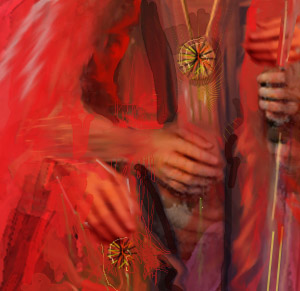
|
Intoxicated, I turned my attention to the portrait of the man, thinking I'd now see a similar effect, but it seemed much less profound. There was no feeling of great space and changing perspectives, but the flat painting seemed to squirm and undulate, revealing, again, many different layers of sketches, underpaintings and overpaintings. These were focused mainly on the man's hands and the golden medallion around his neck, which changed positions a number of times. There seemed to be a greater significance to this than the artist simply changing his mind and composition, but I could not grasp it. |
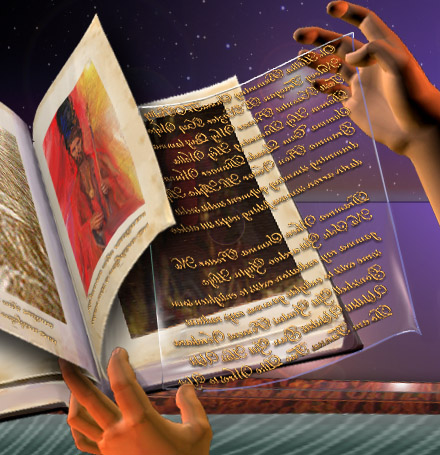
|
I flipped through the rest of the book and discovered that most of the other images it contained were dark, incomprehensible and highly abstract—splashes and smears of black, ochre and brown. They seemed in most cases to be like formless details of larger canvases, and none showed any special properties. Inserted between many of the pages, I found transparent films covered in the golden script and I looked at some of these from both sides, but the writing still appeared to be backward from either direction. I was able to determine it was definitely a Latinate language and decided it must be either French or Italian. The calligraphy, though obviously done by hand, was amazingly precise and beautiful. |
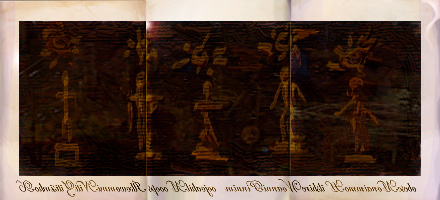
|
Some of the pages folded out into two, three or more panels. Again, all of these that I saw were abstract and formless except for a single three page fold-out which depicted a number of crude, wet-on-wet renderings of people, almost stick figures, each standing on some sort of low pedestal and each having a childish solar symbol—a circle surrounded by a number of crude rays—above its head. It occurred to me for some reason that these were like 'ushabiti,' the small Egyptian funerary statues. |
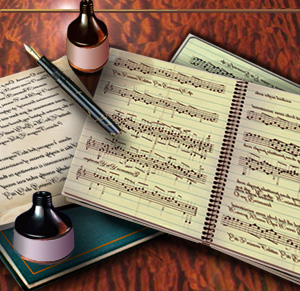
|
Eventually, I put the book aside and examined the contents of the table in front of me. Inkpots and antique fountain pens lay among journals and sketchbooks, some obviously open to the pages of their last entries. There were manuscripts of very complex sheet music. All of the writing was in the same back-handed script and I concluded they were all the work of the same person. I tried to connect this to the woman who owned the house, but it didn't feel intuitively correct. I realized the book of images I had been holding was just another of these journals and that its look and feel of being a printed book was a perplexing deception. All of this gave me an uneasy feeling. Again, I had the contrary feelings that these were both 'famous' works, works that I should know, and that I was seeing them for the first time. I felt I should somehow recognize the author of all of these manuscripts, but could not make any connection. |
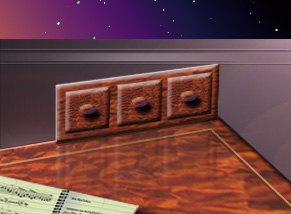
|
At
the far corners of the table were small panels which had a number of
drawer facings. Though the depth of these panels could not possibly
contain real drawers and I assumed they were merely some sort of
decoration, I decided to try to open one...
|
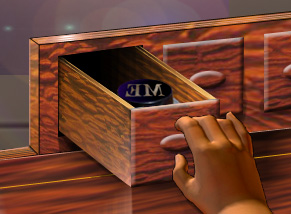
|
Impossibly,
a long drawer opened from the tiny space and I could not decide how such
an interesting effect was engineered. Inside were sundry ordinary
items and I suddenly felt like I was 'snooping' and became a bit
apprehensive, but became curious about a small jar within and examined
it.
|
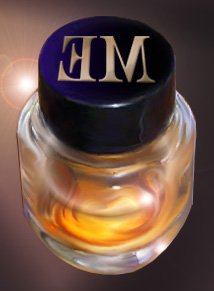
|
The jar contained a heavy, viscous fluid which looked and behaved exactly like honey, yet I immediately recognized that this was in fact the golden ink I had seen on the transparent films. Apparently this fluid would dry to an opaque, metallic finish when applied, although I was uncertain how I knew this to be the case. I puzzled for some time over the strange 'monogram' on the lid of the vessel. (It did not occur to me at the time that this might be the word 'we' upside-down, or the word 'me' backward.) I felt certain that it stood for the sound 'em' even though the 'E' was clearly backward. I could not think of what the word 'em' might mean. I knew of the common use of 'em' in crossword puzzles, a word for a type-setting bit of one space, and the phrase 'embalming fluid' repeatedly occurred to me, but I was almost certain neither of these were applicable. |
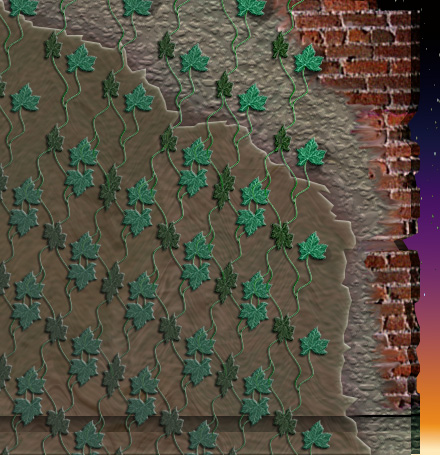
|
I stood and examined the walls and quickly realized that rather than being ruined, they had been meticulously crafted to appear this way, like a stage set, and the effect was beautifully rendered and very convincing. Then I noticed that the ivy which clung to the walls had been 'trained' to grow in a complex, regular geometric pattern: it was real, living ivy, yet it grew with an impossible perfection that caused it to look like wallpaper. I examined it closely in several areas to convince myself that this could be. This alien bit of horticulture amazed and perplexed me for a moment, and then I finally caught site of the panorama beyond the unwalled room... |
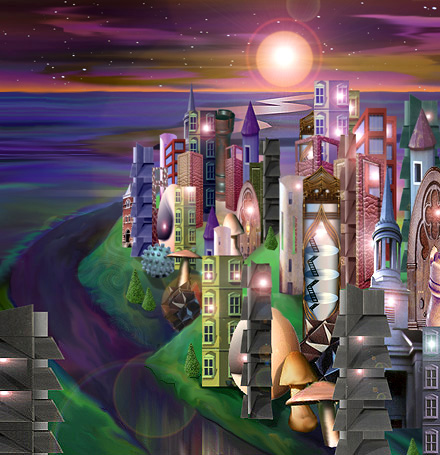

|
One building stood out particularly, being directly across the river from me and brightly lit from within. It appeared to be made of some sort of ceramic. Its gleaming, glossy white surfaces were ornately trimmed in a sort of arabesque fretwork of mirror-finished gold and its great cylindrical window revealed stairways within. Many of the houses had the look of churches, but I deduced from the activities within that they were merely 'ordinary' homes.
My stay was very brief, spanning perhaps less than ten minutes from becoming conscious of the book in my lap, to looking out over Little Venice. As soon as I had fully taken my situation in, at the peak of surreal lucidity, I heard an odd bell ring a number of times: a pure, low and piercing tone not at all like a bell really, yet I knew it was a bell. And I also knew that 'it was time to go.' As I watched, everyone in Little Venice began to react, all making ready to leave and filing out of their homes. I knew the woman that lived in 'my' house would be coming for me and that we would be going together, following all the other Little Venetians in a trek along the river, toward the west, to a gathering, some event about which I knew nothing. I awoke abruptly. • |